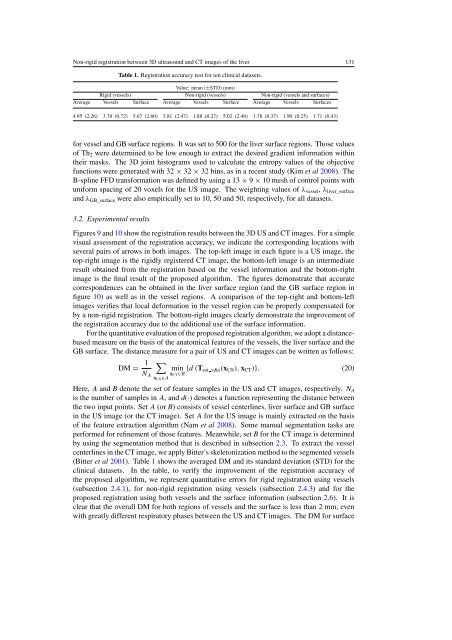Non-rigid registration between 3D ultrasound and CT ... - isl, ee, kaist
Non-rigid registration between 3D ultrasound and CT ... - isl, ee, kaist
Non-rigid registration between 3D ultrasound and CT ... - isl, ee, kaist
Create successful ePaper yourself
Turn your PDF publications into a flip-book with our unique Google optimized e-Paper software.
<strong>Non</strong>-<strong>rigid</strong> <strong>registration</strong> <strong>betw<strong>ee</strong>n</strong> <strong>3D</strong> <strong>ultrasound</strong> <strong>and</strong> <strong>CT</strong> images of the liver 131Table 1. Registration accuracy test for ten clinical datasets.Value: mean (±STD) (mm)Rigid (vessels) <strong>Non</strong>-<strong>rigid</strong> (vessels) <strong>Non</strong>-<strong>rigid</strong> (vessels <strong>and</strong> surfaces)Average Vessels Surface Average Vessels Surface Average Vessels Surfaces4.95 (2.26) 3.78 (0.72) 5.67 (2.60) 3.81 (2.47) 1.88 (0.27) 5.02 (2.48) 1.78 (0.37) 1.90 (0.25) 1.71 (0.43)for vessel <strong>and</strong> GB surface regions. It was set to 500 for the liver surface regions. Those valuesof Th 2 were determined to be low enough to extract the desired gradient information withintheir masks. The <strong>3D</strong> joint histograms used to calculate the entropy values of the objectivefunctions were generated with 32 × 32 × 32 bins, as in a recent study (Kim et al 2008). TheB-spline FFD transformation was defined by using a 13 × 9 × 10 mesh of control points withuniform spacing of 20 voxels for the US image. The weighting values of λ vessel , λ liver_surface<strong>and</strong> λ GB_surface were also empirically set to 10, 50 <strong>and</strong> 50, respectively, for all datasets.3.2. Experimental resultsFigures 9 <strong>and</strong> 10 show the <strong>registration</strong> results <strong>betw<strong>ee</strong>n</strong> the <strong>3D</strong> US <strong>and</strong> <strong>CT</strong> images. For a simplevisual assessment of the <strong>registration</strong> accuracy, we indicate the corresponding locations withseveral pairs of arrows in both images. The top-left image in each figure is a US image, thetop-right image is the <strong>rigid</strong>ly registered <strong>CT</strong> image, the bottom-left image is an intermediateresult obtained from the <strong>registration</strong> based on the vessel information <strong>and</strong> the bottom-rightimage is the final result of the proposed algorithm. The figures demonstrate that accuratecorrespondences can be obtained in the liver surface region (<strong>and</strong> the GB surface region infigure 10) as well as in the vessel regions. A comparison of the top-right <strong>and</strong> bottom-leftimages verifies that local deformation in the vessel region can be properly compensated forby a non-<strong>rigid</strong> <strong>registration</strong>. The bottom-right images clearly demonstrate the improvement ofthe <strong>registration</strong> accuracy due to the additional use of the surface information.For the quantitative evaluation of the proposed <strong>registration</strong> algorithm, we adopt a distancebasedmeasure on the basis of the anatomical features of the vessels, the liver surface <strong>and</strong> theGB surface. The distance measure for a pair of US <strong>and</strong> <strong>CT</strong> images can be written as follows:DM = 1 ∑minN {d (T est v&s(x US ), x <strong>CT</strong> )}. (20)A x <strong>CT</strong> ∈Bx US ∈AHere, A <strong>and</strong> B denote the set of feature samples in the US <strong>and</strong> <strong>CT</strong> images, respectively. N Ais the number of samples in A, <strong>and</strong> d(·) denotes a function representing the distance <strong>betw<strong>ee</strong>n</strong>the two input points. Set A (or B) consists of vessel centerlines, liver surface <strong>and</strong> GB surfacein the US image (or the <strong>CT</strong> image). Set A for the US image is mainly extracted on the basisof the feature extraction algorithm (Nam et al 2008). Some manual segmentation tasks areperformed for refinement of those features. Meanwhile, set B for the <strong>CT</strong> image is determinedby using the segmentation method that is described in subsection 2.3. To extract the vesselcenterlines in the <strong>CT</strong> image, we apply Bitter’s skeletonization method to the segmented vessels(Bitter et al 2001). Table 1 shows the averaged DM <strong>and</strong> its st<strong>and</strong>ard deviation (STD) for theclinical datasets. In the table, to verify the improvement of the <strong>registration</strong> accuracy ofthe proposed algorithm, we represent quantitative errors for <strong>rigid</strong> <strong>registration</strong> using vessels(subsection 2.4.1), for non-<strong>rigid</strong> <strong>registration</strong> using vessels (subsection 2.4.3) <strong>and</strong> for theproposed <strong>registration</strong> using both vessels <strong>and</strong> the surface information (subsection 2.6). It isclear that the overall DM for both regions of vessels <strong>and</strong> the surface is less than 2 mm, evenwith greatly different respiratory phases <strong>betw<strong>ee</strong>n</strong> the US <strong>and</strong> <strong>CT</strong> images. The DM for surface


